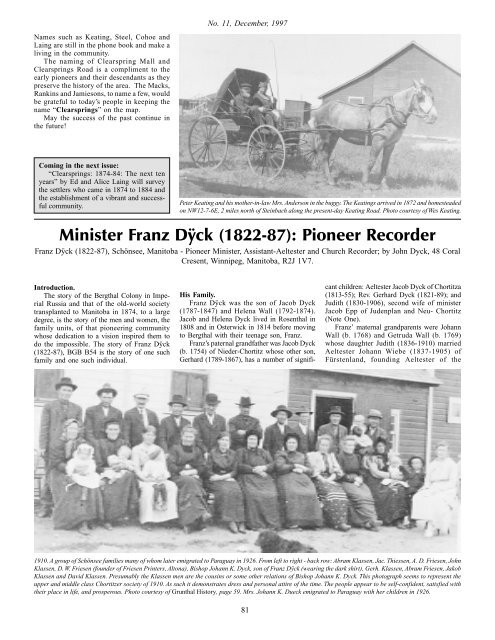Preservings 11 (1997) - Plett Foundation
Preservings 11 (1997) - Plett Foundation
Preservings 11 (1997) - Plett Foundation
Create successful ePaper yourself
Turn your PDF publications into a flip-book with our unique Google optimized e-Paper software.
Names such as Keating, Steel, Cohoe and<br />
Laing are still in the phone book and make a<br />
living in the community.<br />
The naming of Clearspring Mall and<br />
Clearsprings Road is a compliment to the<br />
early pioneers and their descendants as they<br />
preserve the history of the area. The Macks,<br />
Rankins and Jamiesons, to name a few, would<br />
be grateful to today’s people in keeping the<br />
name “Clearsprings” on the map.<br />
May the success of the past continue in<br />
the future!<br />
Coming in the next issue:<br />
“Clearsprings: 1874-84: The next ten<br />
years” by Ed and Alice Laing will survey<br />
the settlers who came in 1874 to 1884 and<br />
the establishment of a vibrant and successful<br />
community.<br />
No. <strong>11</strong>, December, <strong>1997</strong><br />
Peter Keating and his mother-in-law Mrs. Anderson in the buggy. The Keatings arrived in 1872 and homesteaded<br />
on NW12-7-6E, 2 miles north of Steinbach along the present-day Keating Road. Photo courtesy of Wes Keating.<br />
Minister Franz Dÿck (1822-87): Pioneer Recorder<br />
Franz Dÿck (1822-87), Schönsee, Manitoba - Pioneer Minister, Assistant-Aeltester and Church Recorder; by John Dyck, 48 Coral<br />
Cresent, Winnipeg, Manitoba, R2J 1V7.<br />
Introduction.<br />
The story of the Bergthal Colony in Imperial<br />
Russia and that of the old-world society<br />
transplanted to Manitoba in 1874, to a large<br />
degree, is the story of the men and women, the<br />
family units, of that pioneering community<br />
whose dedication to a vision inspired them to<br />
do the impossible. The story of Franz Dÿck<br />
(1822-87), BGB B54 is the story of one such<br />
family and one such individual.<br />
His Family.<br />
Franz Dÿck was the son of Jacob Dyck<br />
(1787-1847) and Helena Wall (1792-1874).<br />
Jacob and Helena Dyck lived in Rosenthal in<br />
1808 and in Osterwick in 1814 before moving<br />
to Bergthal with their teenage son, Franz.<br />
Franz’s paternal grandfather was Jacob Dyck<br />
(b. 1754) of Nieder-Chortitz whose other son,<br />
Gerhard (1789-1867), has a number of signifi-<br />
81<br />
cant children: Aeltester Jacob Dyck of Chortitza<br />
(1813-55); Rev. Gerhard Dyck (1821-89); and<br />
Judith (1830-1906), second wife of minister<br />
Jacob Epp of Judenplan and Neu- Chortitz<br />
(Note One).<br />
Franz’ maternal grandparents were Johann<br />
Wall (b. 1768) and Getruda Wall (b. 1769)<br />
whose daughter Judith (1836-1910) married<br />
Aeltester Johann Wiebe (1837-1905) of<br />
Fürstenland, founding Aeltester of the<br />
1910. A group of Schönsee families many of whom later emigrated to Paraguay in 1926. From left to right - back row: Abram Klassen, Jac. Thiessen, A. D. Friesen, John<br />
Klassen, D. W. Friesen (founder of Friesen Printers, Altona), Bishop Johann K. Dyck, son of Franz Dÿck (wearing the dark shirt), Gerh. Klassen, Abram Friesen, Jakob<br />
Klassen and David Klassen. Presumably the Klassen men are the cousins or some other relations of Bishop Johann K. Dyck. This photograph seems to represent the<br />
upper and middle class Chortitzer society of 1910. As such it demonstrates dress and personal attire of the time. The people appear to be self-confident, satisfied with<br />
their place in life, and prosperous. Photo courtesy of Grunthal History, page 59. Mrs. Johann K. Dueck emigrated to Paraguay with her children in 1926.
















